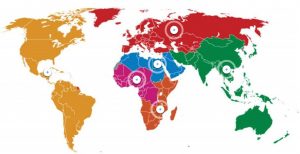 Strengthening your supply chain one link at a time.
Strengthening your supply chain one link at a time.
Tariffs or customs duties are fundamentally nothing more than taxes levied on imported goods. With international trade policies dependent upon philosophical, political, and strategic considerations, the function of the tariff is constantly reevaluated. Since the initial tariff commission’s inception through today, the schedules have been amended and modified by legislation and trade agreement negotiations. This first blog provides a timeline of events that led to the governing structure in place today, for the international tariff system and United States schedule.
From 1800-1860, the U.S. government generated an average 90% of its revenue from customs duties, when war or depression weren’t occurring. Throughout the 1800’s, after a conflict concluded, the duties’ revenue recovered at an average rate of 15%.
PERCENTAGE OF U.S. FEDERAL REVENUE GENERATED BY CUSTOMS DUTIES FROM 1791-1975
![]()
In 1883, the U.S. Congress created a board / commission of experts to investigate the import revenue system and recommend changes in the tax and tariff structure, to lower the tariff. However, the commission was unable to deliver on its original objectives and the concept ultimately failed.
From 1907-1915, multiple parties resurrected the concept to form a non-partisan, U.S. commission to investigate various aspects of the U.S. tariffs plus general world trade conditions. A bill was passed and on March 26, 1917 the “United States Tariff Commission” (or “Tariff Commission”), consisting of six (6) Presidentially appointed Commissioners, assumed their duties. This was the first independent, Government agency to advise Congress and the President on tariff and trade matters. Its major function would be to determine the minimum tariff levels required to protect U.S. producers.
On April 2, 1917, the U.S. officially entered WWI (1914-1918). The disturbing effects the war had upon the nation’s economic activities slowed the Tariff Commission’s work through 1922.
Then, the Great Depression hit in August 1929 and lasted through March 1933. This forced U.S. statesmen and politicians to reconsider how their internal U.S. and personal actions could affect the whole world.
The U.S. entered WWII (1939 – 1945) in December 1941. In the late 1940’s, U.S. economic policies evolved to isolating the Communist bloc (Soviet Union and Communist China) and insulating the rest of the world from its intrusions.
During the General Agreement on Tariffs and Trade (GATT) negotiations in Belgium in September 1947, participants had raised Customs’ process questions, then realized that no institution carried responsibility for examining these issues. This sparked the creation of the Customs Co-operation Council (CCC) with 17 European countries on November 4, 1952. It was responsible for implementing a common European tariff nomenclature and Customs valuation. The CCC’s main function was (and is) “to establish and maintain international instruments for harmonization, uniform, and simplified application of Customers procedures governing the movement of commodities, people, and means of conveyance”.
By the 1950’s, the U.S. Tariff Commission had reverted back to performing the service it had originally been mandated to carry out in 1916, providing the Government with information on foreign economic developments and on international trade and its effects on domestic production.
In 1963, the Tariff Commission published its first, official (by law) tariff rate schedules, “Tariff Schedules of the United States Annotated (TSUSA)”.
In January 1975 the Tariff Commission changed its name to “United States International Trade Commission” (USITC), which better reflected the nature of its mission since it had always dealt with U.S. imports, exports and general conditions of international trade.
In the 1970’s, the USITC and the CCC started working together to link and standardize the internal U.S. and European tariff schedules.
On January 1, 1988, 37 countries in the CCC (100 members at that time) made effective the “Harmonized Commodity Description and Coding System” (or “Harmonized System”/“HS”). The HS is one of its instruments and is the universal tariff language for all countries using this structure.
A year later, the U.S. Congress made effective the “Harmonized Tariff Schedule” (HTS), replacing the former TSUSA schedule. It is used for U.S. imports and the basis for exports. The Department of Homeland Security’s Bureau of Customs and Border Protection (CBP) is solely authorized to use this system’s rules to classify goods. The USITC publishes and maintains the HTS. The HTS was built by utilizing the CCC’s HS nomenclature structure; therefore, this HTS implementation marks the official coordination between the CCC and the USITC.
In 1994, the CCC adopted the name “World Customs Organization” (WCO) to reflect its worldwide reach. It gradually became an international organization due in part to the importance of Customs to national economies. It is now comprised of 212 countries in six (6) global regions, responsible for processing approximately 98% of international trade.
World Customs Organization (WCO) Regions

The WCO formed a “Tariff and Trade Affairs Office” in 1995 and delegated its HS responsibilities to it.
These organizations’ responsibilities have remained consistent since 1995:
Stay tuned for more on how the current state of US Tariff affairs impacts global supply chains.
–Jess Kittrell, St. Onge Company